Celandine: The delicate flower, harbinger of spring, which Wordsworth thought more beautiful than daffodils
Lauded by Wordsworth for their ‘glittering countenance’, the appearance of the first celandines and the swallow’s return to our shores are Ian Morton’s favourite, and much anticipated, harbingers of spring.

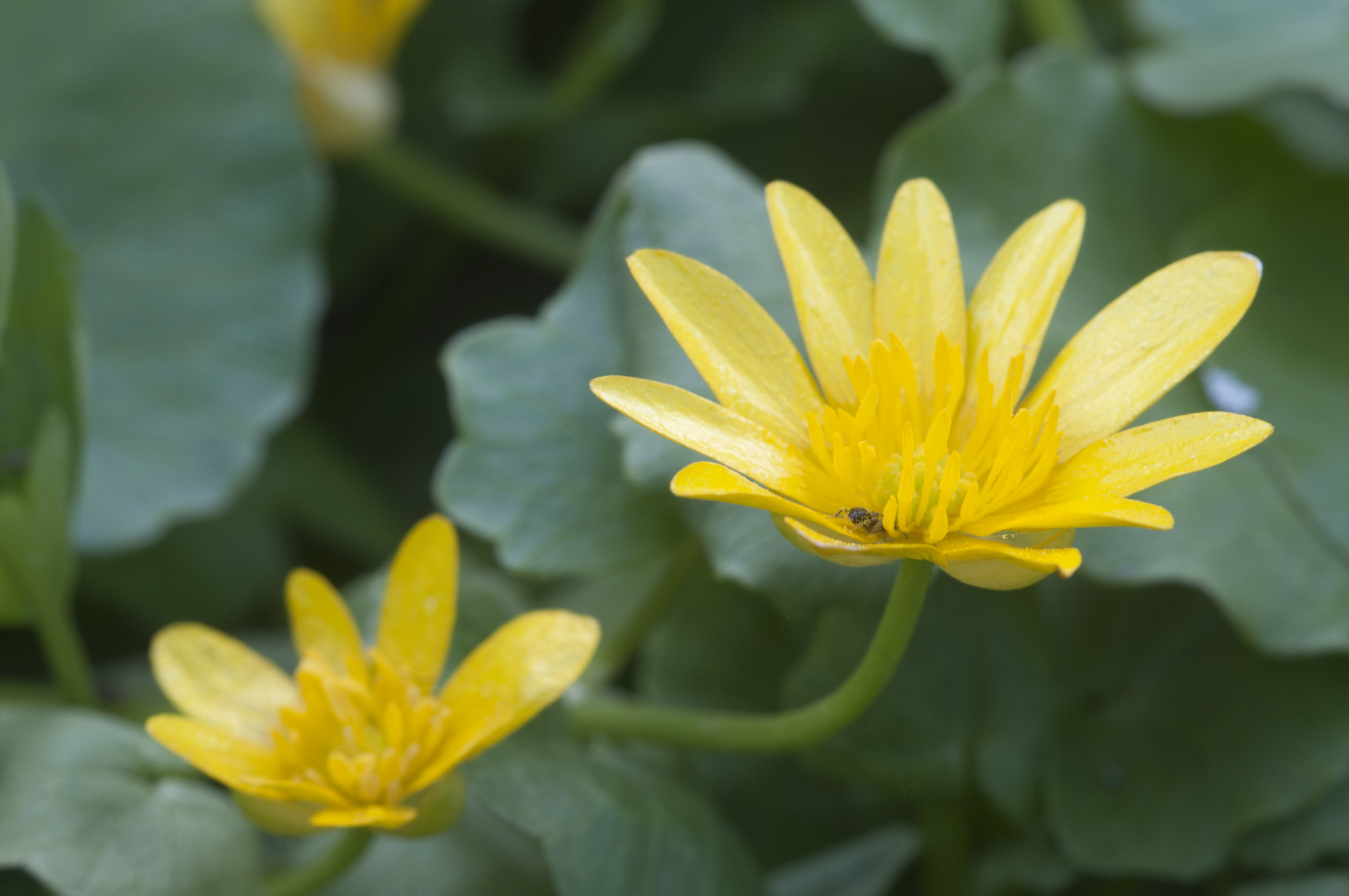
The nation waits — when will the first swallows be sighted? Records kept since Victorian times indicate March as the most likely month, although the migrants often arrive earlier. Hampshire naturalist and diarist Gilbert White noted in his Natural History and Antiquities of Selborne (first published in 1789 and never out of print since) that ‘the House Swallow... appears in general on or about the 13th of April... now and then a straggler is seen much earlier’. In 2018 and 2019, sightings in the south of the country were reported during unusually warm spells in early February.
Rural tradition held February 21 to be the date when the bird should arrive, but the swallow was not alone in greeting the new season of growth, for on that day, too, the lesser celandine was expected to bloom. Here was no coincidence. Celandine is an anglicised form of chelidon, the Greek for swallow. From distant days past, bird and plant were twin harbingers of spring — and they still are.
Never mind the host of golden daffodils that flash upon the inward eye, William Wordsworth actually preferred the celandine. ‘There’s a flower that shall be mine, ’tis the little celandine,’ he wrote in one of three poems he devoted to the modest, ground-hugging plant.
The spread of pointed petals and its ‘glittering countenance’ would have inspired painters who sought to depict the sunrise, he suggested. Perhaps he knew that the Celts called the plant crian, their word for the sun. Indeed, Wordsworth loved the lesser celandine so much that he asked for it to be engraved on his tombstone in St Oswald’s churchyard, Grasmere. A celandine duly appears on his memorial plaque in the church, but, oh dear — unwittingly, the artist chose the wrong celandine.
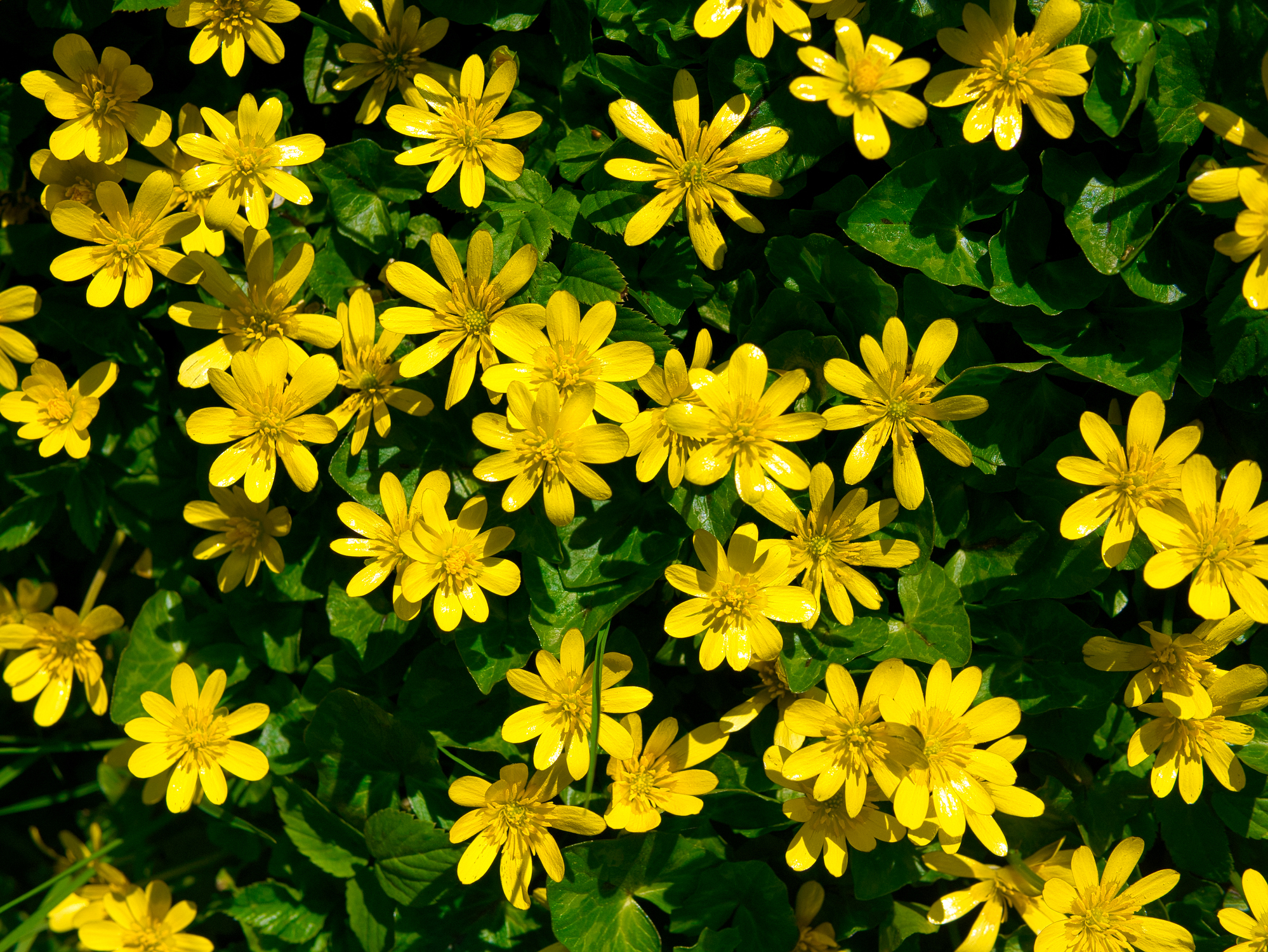
The poet’s lesser celandine is a member of the buttercup family and, despite the similarity in appearance and their linked membership of the Ranunculus order, the greater celandine belongs to the poppy family, the two plants having been classified in the mid 18th century. Wordsworth may not have despaired, however, as writers seem to have risen above any need to distinguish between them.
An earlier poet to extol the celandine was William Browne of Tavistock, whose 1613 work described it as ‘a shepherdess of matchless beauty’. Others who lauded the celandine included poet and essayist Edward Thomas, who died at Arras in 1917, and novelists C. S. Lewis and D. H. Lawrence. The latter, in Sons and Lovers, remarked on their ‘scalloped splashes of gold’.
At home in damp woodland, the lesser celandine is one of the first plants to show flowers before the leaf canopy excludes light. It dies back in May and remains dormant for the rest of the year. Its folk names included spring messenger, smallwort, brighteye, cheesecups, butter and cheese, kenningwort, gentleman’s cap and frills, golden guinea and frog’s foot (the Ranunculus order is rooted in the Latin for frog, rana, which prefers the moist habitat also liked by the plant).
Exquisite houses, the beauty of Nature, and how to get the most from your life, straight to your inbox.
In the language of flowers, the lesser celandine signifies ‘joys to come’. A less attractive folk alternative was pilewort, the name accorded by the Doctrine of Signatures, which propounded the tradition that if a plant or a section thereof resembled a part of the human body, then it could be used to treat a condition afflicting that part. The celandine’s tuber root was taken to look like a haemorrhoid and, according to the Doctrine, it was also known as figwort — figs being an archaic though graphic name for piles.
To confuse the etymology further, the plant’s Latin name is ficaria verna, spring figs. In the US, where the lesser celandine is condemned in several states as invasive and toxic to grazing livestock, it’s known as the fig buttercup.

Its glossy petals, of which it has from seven to 12, share their structure with the buttercup and another relative, the marsh marigold. Research by Gronigen University in the Netherlands has determined that the petal surface has an optical layer one cell thick that radiates light both outward and inward. The inner surface scatters light to layers of air, starch and mesophyll below, the starch deflecting it back so that it passes twice through the pigment to produce that rich yellow.
The surface shine is seen by obliquely approaching insects as a flash of brightness, beckoning a pollinator, and the petals close overnight, as well as in the day when rain is due.
Although it propagates through its dozen or so tubers that detach to form new plants, it also produces granular seeds in the junctions between stem and leaves. In heavy rain, these may wash off and gather in drainage channels, giving rise to the country myth of a ‘rain of wheat’.
The lesser celandine retreats in May, when the four-petal blooms of the greater celandine take over and last until September. The classified name of this version, Chelidonium majus, refers directly to the Greek and claims a history of wider and more varied medicinal application. Remarked by Pliny and Dioscorides and recommended for toothache, eye problems, gallstones and dyspepsia, its range of isoquinoline alkaloids argues today that even a moderate herbal dose would have been dangerous unless the toxicity had been eliminated by cooking or drying.
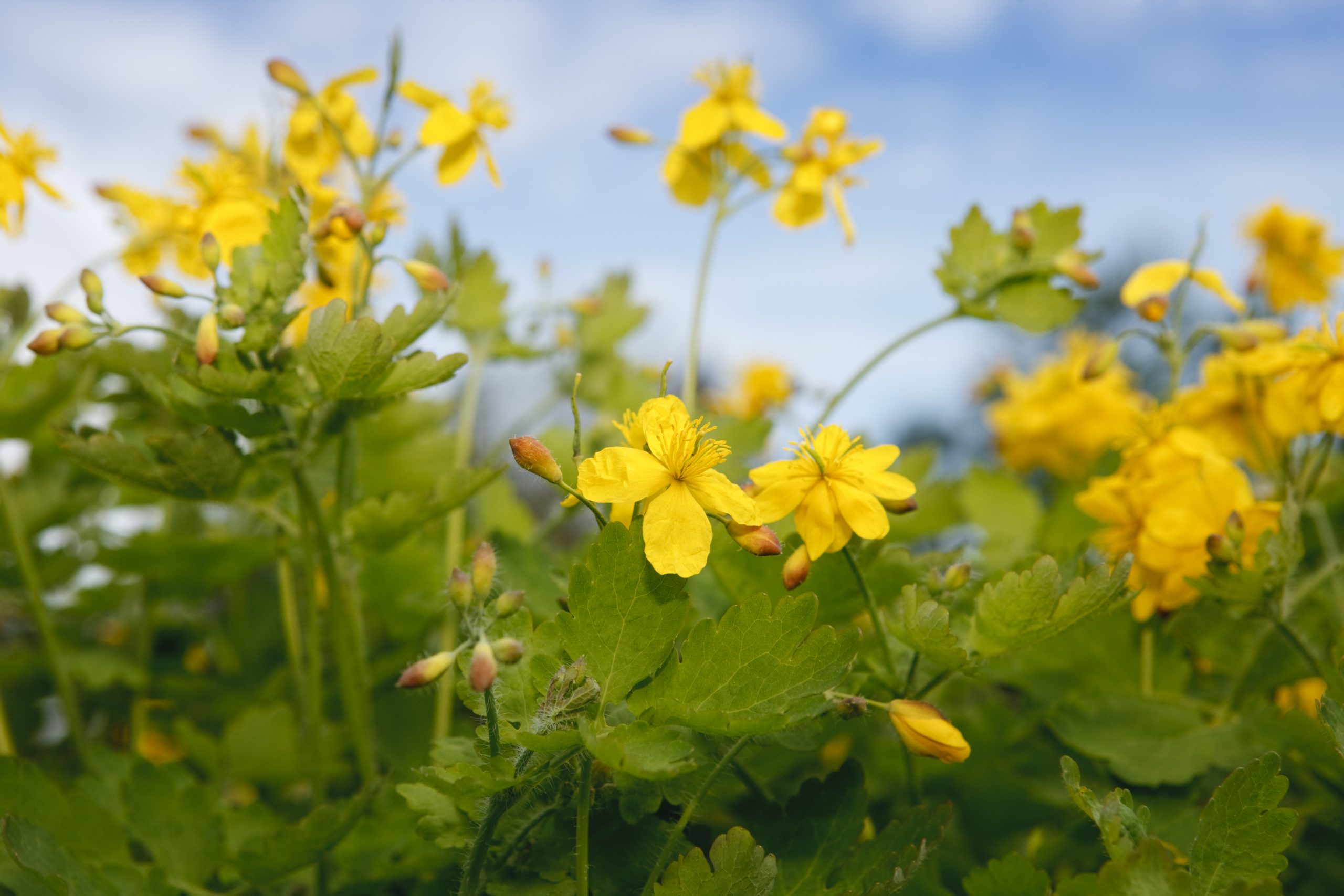
Folk names included yellow spit, swallowwort, nipplewort, tetterwort (tetters being skin problems, such as ringworm and eczema) and wartwort, the applied juice being corrosive. The swallow association related not only to the birds’ presence, but also to an ancient belief that, if the eyes of swallow fledglings were pecked out, the parent birds restored them with the juice of the plant. Anglo-Saxon medicine prescribed an infusion of the plant rendered lukewarm with honey in a brass or copper pot as an eye salve, its value first recorded in 1310. The notion of its optical properties survived in John Gerard’s Herbal of 1597, which declared that ‘it cleanseth and consumeth awaie slimie things that cleave about the ball of the eye’.
Nicholas Culpeper maintained the medicinal faith in both celandines in his 1792 Herbal. Of the lesser plant, he declared that ‘if you dig up the root of it, you shall perceive the exact image of the disease which they commonly call the piles’. An oil or ointment ‘readily cures both the piles... and the king’s evil’. This latter condition was scrofula, glandular swellings in the neck now recognised as a TB symptom, but traditionally curable if touched by a royal hand, a superstition that only died with Queen Anne in 1714.

Culpeper asserted that he cured his own daughter of scrofula with lesser-celandine ointment that ‘broke the sore, drew out a quarter of a pint of corruption, and healed without any scar at all in a week’s time’. He further declared that the plant had a comprehensive effect and, if kept on the skin ‘helps in such diseases though it never touch the place grieved’.
Culpeper also described the greater celandine as ‘one of the best cures for the eyes — most desperate sore eyes have been cured by this only medicine’. He added that it was ‘best to allay the sharpness with a little breast milk’. The plant and root boiled in white wine and taken with aniseed ‘opens obstructions of the liver and gall, helps the yellow jaundice... helps the dropsy and the itch, and those that have old sores’. A distillation of the greater celandine could be used ‘with a little sugar and a good little treacle against the pestilence’. Culpeper was reiterating the tradition of ‘plague-water’, the celandine being one of a dozen plants that, if distilled in white wine and stirred for three days, was thought to protect against contagion.
Mystics suppose that the greater celandine signals happiness, cures depression and, if put on a pillow, generates prophetic dreams. Folklore had it that a witch who carried a plant in a red bag hung around her neck hoped thereby to avoid detection and imprisonment.
Conversely, a floor scrubbed with water in which celandine had been infused was supposed to deter witches and burning the plant as incense had the same effect. However, across the Atlantic, the plant was said to deter officials — especially law enforcers and tax collectors — and to aid escape.

Credit: Alamy
11 things you never knew about the jackdaw, the bird that just loves people
Ian Morton takes a look at the jackdaw, a bird with a real affinity for man – despite a chequered reputation
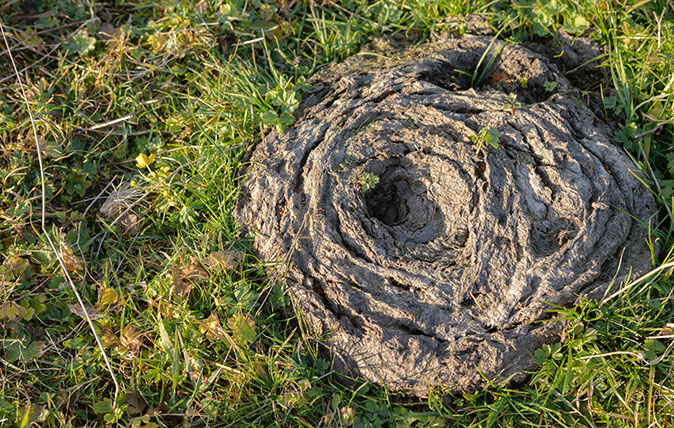
Credit: Alamy
The delights of dung: 11 things you never knew about cowpats
It attracts no public regard apart from taking care not to step in it, but it plays a big role
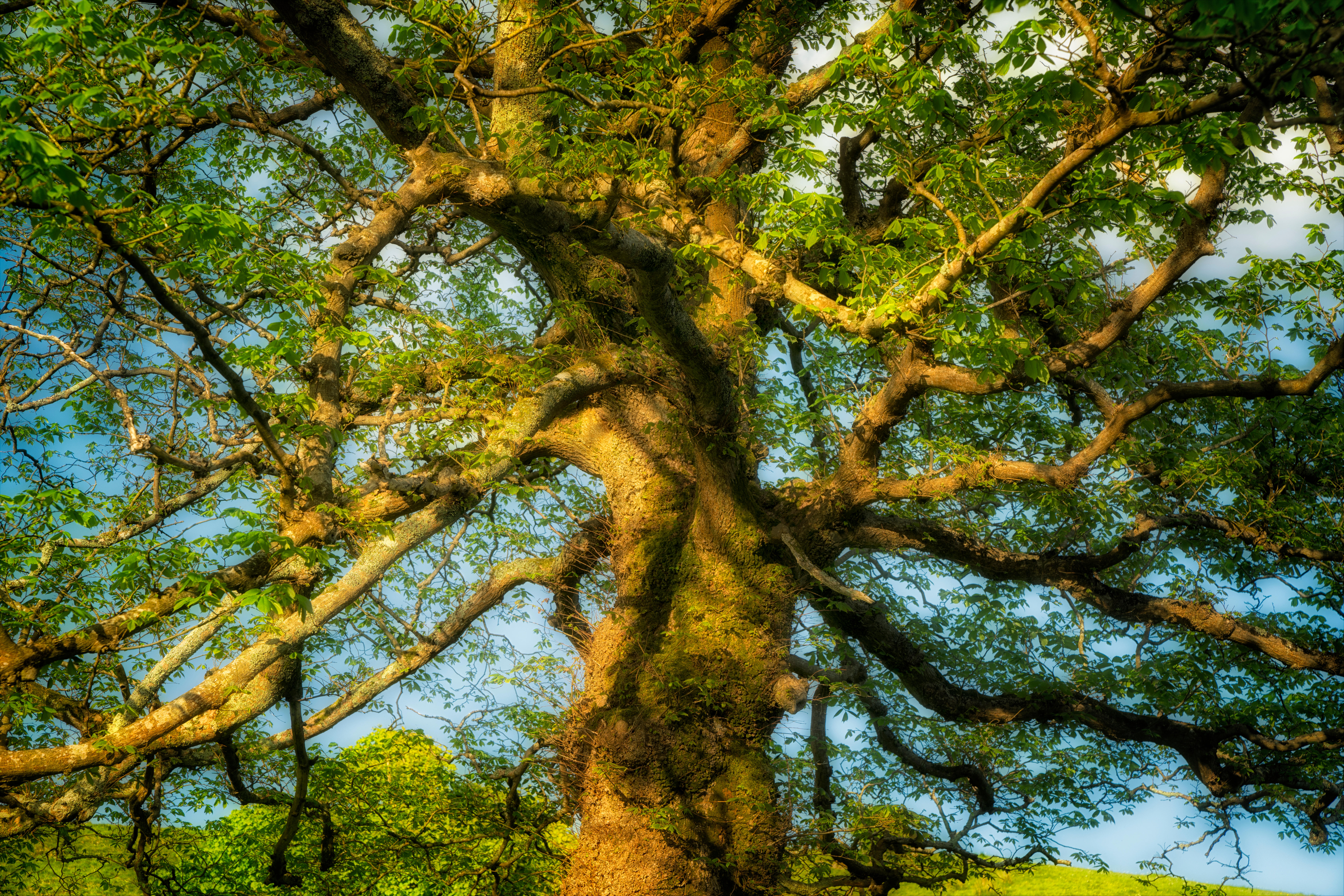
The history of the elder tree: From deities and dryads to Shakespeare and J.K. Rowling
Does our love of a tall glass of elderflower cordial speak of an ancient connection with the tree itself, wonders

The wren: 8 things you ought to know about Britain's most common bird
It may be diminutive, but the perky-tailed wren has a powerful song and the ancient title of king among birds,

The incredible tale of the foxglove, from curing to disease to inspiring Van Gogh’s most striking paintings
A tale of skulduggery, poisoning, witches and even marketing men runs through the history of the foxglove, as Ian Morton
After some decades in hard news and motoring from a Wensleydale weekly to Fleet Street and sundry magazines and a bit of BBC, Ian Morton directed his full attention to the countryside where his origin and main interests always lay, including a Suffolk hobby farm. A lifelong game shot, wildfowler and stalker, he has contributed to Shooting Times, The Field and especially to Country Life, writing about a range of subjects.
